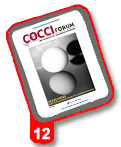COCCI Profile: Simple Math
Vaccinating layers for coccidiosis was an easy decision for UK's Deans Foods.
 Joret: 'The program has been very successful.' |
The decision by Deans Foods "the largest egg marketer in the UK "to eliminate in-feed anticoccidials from its company-owned layer operations in favor of vaccination is one recent example.
In this case, however, management didn't need high-performance computers or elaborate spreadsheets to make their decision. It was a matter of simple math.
"Our decision to vaccinate was driven by two things," explains Andrew Joret, operations director-agriculture for Deans Foods.
"One, we were seeing a growing number of birds with coccidiosis breaks, even though they had been treated with in-feed anticoccidials. That suggested resistance problems," he explains.
"The second is that the number of in-feed drugs available to us is diminishing rapidly. We know it's a good practice to rotate anticoccidials, but between resistance and residue issues, there's not going to be anything left to rotate in the future. It was clear that we needed to look at vaccination more closely."
Getting it right
Vaccinating layers for coccidiosis with Paracox (also known as Paracox-8 in some markets) is not entirely new to Deans. The company tinkered with the practice in previous years but the results were sometimes inconsistent, an outcome they now realize was due to the error of their ways."A lot of the problems we had earlier resulted from us trying to cut corners a wee bit and save money by not using the full dose of the vaccine," he says. "But closer scrutiny provided a solution, which is that Paracox at full strength is the only way to go."
According to Dr. Charlie Broussard, director of global technical services for Schering-Plough Animal Health, the company that makes Paracox, using the correct dose is particularly important with coccidiosis vaccines because they provide a controlled and carefully balanced dose of oocysts, or eggs, of the Eimeria pathogens that cause coccidiosis. These in turn stimulate the bird's immune system, providing lifelong protection against coccidiosis without resorting to resistance-prone drugs.
"If you use anything less than the full dose of the vaccine, you cannot achieve optimum uptake of the oocysts, nor can you expect there to be adequate protection," he adds.
Good training essential
Good training is also critical to the vaccine's success."With vaccines, whether it's Paracox or anything else, it's all about how they're applied on the farm," Joret insists. "If your farm managers aren't properly trained, you can't expect to have good results. Since committing to this program, we have not had any cocci problems to speak of. I think training has been the key."
To make sure all farm managers were in sync with the new program, which involves administering the vaccine through the drinking water at 5 days, Joret sought assistance from local Schering-Plough representatives.
Besides dispatching technical personnel to the farms, Schering-Plough worked with Deans to produce Eggstra, an in-house publication that reviewed vaccine protocols and provided handy worksheets, checklists and reminders to help ensure successful vaccination.
Wanting to provide even more incentive for farm managers to learn proper and successful vaccination procedures, Deans and Schering-Plough also developed a contest to see which operations could administer the vaccine most effectively.
According to Schering- Plough poultry business manager Iain Brown, this involved getting managers to collect 10 individual fecal droppings from each shed so a laboratory could determine the level of vaccine uptake by the flock.
Counting oocysts
Why fecal testing?"We know that the laboratory-produced vaccine strains have a shorter life cycle inside the bird than the wild strains that occur in the field," says Dr. Sarah Rennie, technical business manager at Schering- Plough.
"By testing 5 days after vaccination, any oocysts found in the sample are more likely to have come from the vaccine than any wild strain, which can take 6 to 7 days to appear in the feces."
One thing fecal tests don't show is the immune status of the bird. Vaccinated birds do not become immune to coccidiosis until 2 weeks after vaccination, but the effect lasts a lifetime.
"But if the vaccine has taken hold, immunity is likely to follow unless some other factor on the farm prevents vaccinated birds from developing immunity. For example, stress, immunosuppressive diseases or poor quality nutrients in the feed can all have an effect on the development of the immune response in vaccinated birds," she says.
Knowing the score
Oocyst counts from the samples are rated on a scale of 1 to 5, with 5 being the highest. She explains that the aim of the program is to have no birds test negative for vaccinal oocysts and to have the birds score from 1 to 3 (1 to 1,000 oocysts per sample)."It is theoretically possible to score 4 or 5 (1,001 to 10,001 oocysts), but this would be exceptional and would probably indicate the presence of wild strain oocysts," she says.
For example:
- Farm A reports that 7 of 10 samples were negative and the other three scored 1 (1 to 10 oocysts). This indicates very poor vaccination.
- Farm B reports that all birds tested positive, but the oocyst count score was low. This suggests "reasonable vaccination," according to Rennie.
- Farm C has all birds testing positive with scores from 1 to 3 (1 to 1,000 oocysts), which suggests the birds are uniformly immune to coccidiosis.
"The competition serves as a reminder for everyone involved in rearing to get it right consistently, whether rearing for our company laying farms or for external pullet sales," Joret says. "The program has been very successful."
You can't keep a good oocyst downCoccidiosis, a ubiquitous protozoan disease common in standard broilers and other floor-raised birds, is routinely spread when infected birds shed oocysts of Eimeria pathogens in their droppings, which contaminate feed, dust, water, litter and soil.Fresh oocysts are not infective until they sporulate, usually in 1 to 2 days under optimal conditions "21°-32°C (70°-90°F) with adequate moisture and oxygen. Oocysts are resistant to most disinfectants commonly used around livestock. They have also shown resistance to in-feed anticoccidials when those medications are used for extended periods. |
'Proved to be effective'
John Simpson, area production manager for Deans' North Region, which encompasses 20 farms in Scotland and the north of England, has also been pleased with the results of the coccidiosis vaccination program."We haven't had a problem with coccidiosis, and we've never had to use a disinfectant on any of the floors," he says. "I was apprehensive at first, but then it's human nature to be apprehensive about change, isn't it? For us, vaccination has proved to be effective and very simple to use."
He notes that in the past birds on infeed anticoccidials sometimes broke with the disease after 6 weeks, which required Deans to use additional antibiotics, which added to the overall cost of the treatment.
Furthermore, the in-feed treatment had to be pulled from the feed at 12 weeks to avoid residue concerns. "That left the birds without any coccidiosis protection from 12 weeks until they started laying eggs at 18 weeks," Simpson says. "The vaccine provides much longer protection, and you don't have to worry about resistance or residues."
To help make up for the loss of any growth promotion effects of in-feed anticoccidials, Deans has also been placing more emphasis on promoting good intestinal health through better nutrition. According to Joret, this involved making a few changes to the layer pullets' feed rations.
"We didn't change the diets themselves," he says. "We only changed the schedules at which they were fed. Without having drugs in the feed, we could be a lot more flexible and focus more on the nutritional needs of the birds."
For example, Deans used to pull birds off the starter feed at 3 weeks and off the rearing feed at 6. Now, the company keeps layer pullets on the starter feed for 4 weeks and extends the rearing feed to 8.
"And that seems to have done the trick," he says.
More on the floorDeans Foods has only one company-owned farm with cage-reared layer pullets. All other birds are reared on floors, a setup that puts the company in good position to meet new EC regulations, which prohibited the installation of any conventional wire layer cages after Jan. 1, 2003, and eliminates them in 2012.Floor-reared birds are generally more susceptible to coccidiosis, which is routinely spread when infected birds shed oocysts, or eggs, of Eimeria pathogens in their droppings, which contaminate feed, dust, water, litter and soil. Even so, Deans' Joret says coccidiosis is still an issue in caged birds and all flocks need to be protected. "The market is definitely moving toward free-range birds, so we're lucky in that respect because most of our rearing was on the floor anyway," he adds. "We're well aware of the threat that coccidiosis presents in these situations." Research by Mintel, a UK-based market research firm, confirms this trend. According to a 2003 report, free-range eggs accounted for 30% of egg sales by volume in the UK compared to just 24% in 1998, representing a 38% rise in sales. Producers also need to be extra careful about drug residues. In January 2004, EU legislation was put in place requiring that every egg be stamped with a home address, producer code, country of origin and "best before" date. While beneficial to consumers, this has proved challenging for egg producers. Fortunately, Joret says, the use of coccidiosis vaccination and better nutrition has allowed Deans to sharply decrease usage of in-feed medicinal additives without compromising performance. |
Source: CocciForum Issue No.12, Schering-Plough Animal Health.







